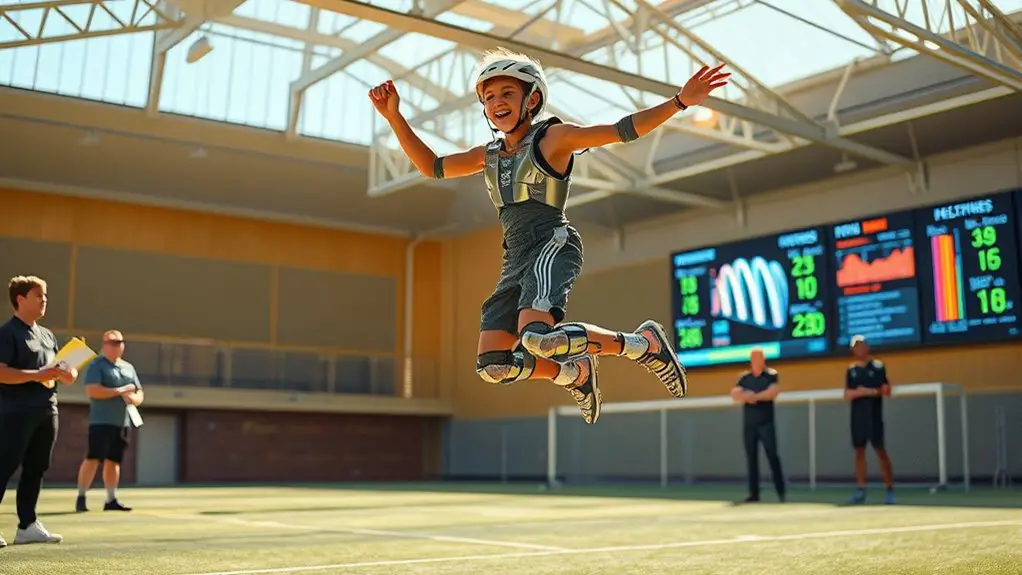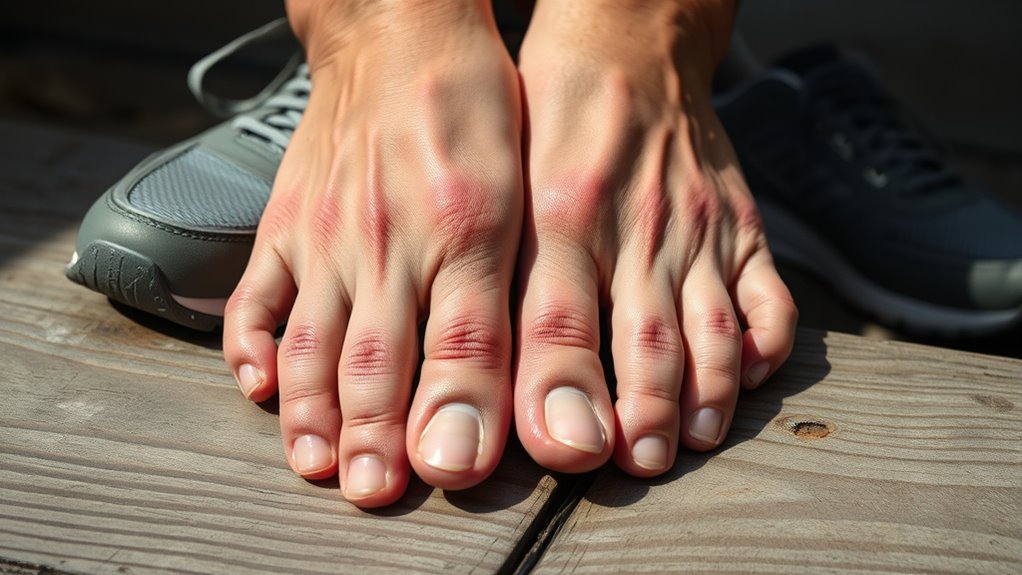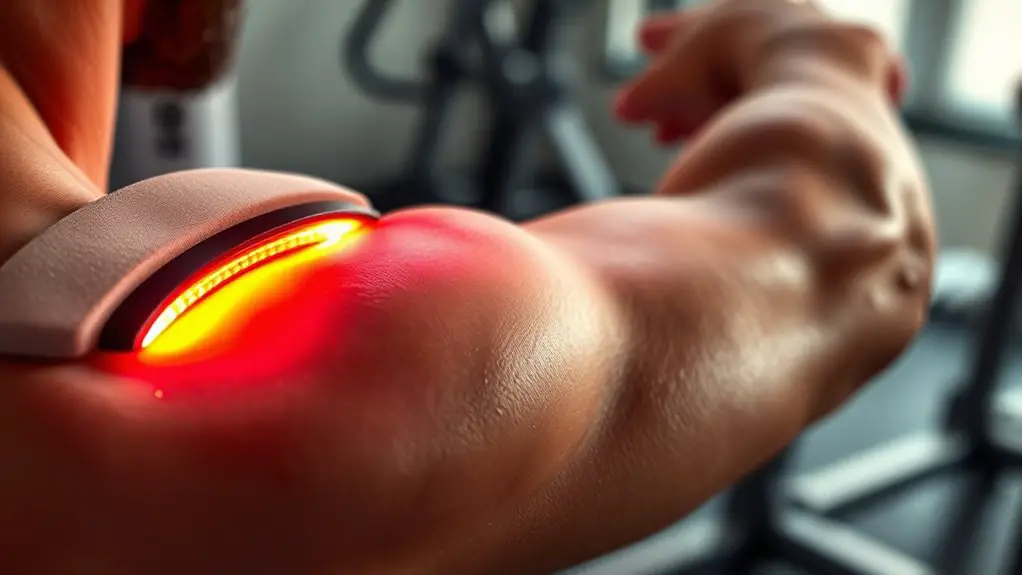Exoskeleton technology is transforming sports training by providing you with enhanced performance support, injury prevention, and personalized training experiences. These futuristic robotic suits mimic natural movement, adapting resistance to your unique strength levels. They help reduce muscle strain and speed up recovery, allowing you to focus on your performance without the risk of injury. As you explore more about how they're revolutionizing training, you'll discover even greater advantages for your athletic journey.
The Basics of Exoskeleton Technology
Exoskeleton technology, while still evolving, has quickly gained traction in various fields, including sports training. You might be surprised to learn how robotic suits are reshaping the landscape of athletic preparation. These innovative devices provide biomechanical support, allowing you to train more efficiently and recover faster. Imagine slipping into a suit that enhances your movement, giving you the freedom to push your limits without the usual wear and tear on your body.
Robotic suits are designed to mimic natural motion, making them intuitive and easy to use. They can help you build strength, improve endurance, and even assist with rehabilitation after injuries. With this technology, you're not just training harder; you're training smarter. By integrating biomechanical support into your routine, you can enjoy the thrill of athletic freedom while minimizing the risk of injury. Furthermore, these suits can enhance your range of motion, which is vital for improving overall performance and reducing injury risks. The future of sports training is bright, and exoskeletons are leading the way.
Enhancing Athletic Performance
With the integration of exoskeleton technology into sports training, athletes are discovering new ways to enhance their performance. Imagine harnessing biomechanical feedback that fine-tunes your movements in real-time. This tech helps you understand your body's mechanics like never before, offering insights that empower you to break through barriers.
Adaptive resistance is another game-changer. It adjusts to your strength levels, allowing you to push your limits safely. You won't just be lifting weights; you'll be engaging in a dynamic training experience that adapts to your progress.
As you embrace this technology, you gain freedom in your training regimen. You can explore new techniques and improve your skills without the usual constraints. Exoskeletons let you redefine what's possible, elevating both performance and personal growth. Additionally, the use of smart wearables allows for real-time monitoring of your body's responses, further enhancing the training experience. Now, it's time to release your potential and transform the way you train!
Injury Prevention and Recovery
As you train harder, the risk of injury inevitably rises, but exoskeleton technology can greatly mitigate that risk. By providing support and reducing strain on your muscles and joints, these devices help you push your limits without the fear of getting sidelined. Injury statistics show that athletes using exoskeletons experience fewer severe injuries, allowing them to maintain their freedom to train without constant worry. Additionally, the incorporation of proper warm-ups and stretching can further enhance the effectiveness of exoskeletons in preventing injuries. When injuries do occur, recovery timelines can feel like an eternity, but exoskeletons can speed up the healing process. They facilitate movement during rehabilitation, enabling you to stay active while you heal. This means you can return to your beloved sport sooner, reclaiming your freedom and passion. With exoskeleton technology, you're not just training harder; you're also training smarter, ensuring that your journey is as injury-free as possible while embracing the thrill of athleticism.
Customized Training Programs
While traditional training programs often take a one-size-fits-all approach, customized training programs tailored to your specific needs and goals can greatly enhance your performance. With exoskeleton technology, you can experience adaptive training that adjusts in real-time based on your movements and strengths. This means you're not stuck in a rigid routine; instead, you're free to explore what works best for your body.
Incorporating athlete feedback is essential. As you train, you can communicate how your body feels and what challenges you're facing. This information helps coaches and trainers refine your program, ensuring it evolves alongside your progress. You're not just following a set plan; you're actively participating in your growth.
Ultimately, these customized training programs empower you to break barriers, release your potential, and enjoy a training experience that's uniquely yours. Additionally, leveraging real-time analytics can provide insights that further enhance your training experience. Embrace the freedom to shape your journey in sports!
Case Studies: Exoskeletons in Action
In this section, you'll see how exoskeletons are transforming strength training and aiding in injury rehabilitation. Real-world examples show just how effective this technology can be for athletes at all levels. Get ready to explore the tangible benefits these innovations bring to sports training.
Enhanced Strength Training
Exoskeleton technology has revolutionized strength training, allowing athletes to push their limits like never before. Imagine strapping into a lightweight exoskeleton that enhances muscle activation during resistance training. You can lift heavier weights and perform more reps without the usual strain. This technology offers you the freedom to explore your potential, helping you break personal records while minimizing fatigue. Case studies show athletes using exoskeletons have experienced significant gains in strength and endurance. You'll feel empowered, knowing you're training smarter, not harder. With real-time feedback and adjustable resistance, exoskeletons adapt to your unique needs, making every workout an opportunity for growth. Embrace this cutting-edge innovation and redefine what's possible in your strength training journey.
Injury Rehabilitation Assistance
As athletes recover from injuries, the integration of exoskeleton technology can greatly enhance rehabilitation outcomes. By utilizing rehabilitation robotics, you can experience improved mobility and strength, paving the way to a quicker return to the field. The exoskeleton benefits include tailored support for your specific injury, allowing for safe and effective movements.
Here's a quick look at some case studies showcasing exoskeletons in action:
| Case Study | Exoskeleton Type | Key Outcome |
|---|---|---|
| Football Player | Lower Limb Exoskeleton | Enhanced Walking Speed |
| Basketball Player | Full-Body Exoskeleton | Improved Balance |
| Runner | Customized Exoskeleton | Pain Reduction |
These advancements are reshaping how you approach recovery, granting you the freedom to reclaim your athletic potential.
The Role of Data and Analytics
While athletes push their limits in training, data and analytics play a crucial role in optimizing their performance. With advanced data collection methods, you can gain critical analytical insights into your training regimen. By monitoring performance metrics, you'll spot trends that can inform your approach. Biomechanical analysis helps you understand how your body moves, allowing for targeted improvements.
Real-time feedback from exoskeleton technology guarantees you're making adjustments on the fly, enhancing your training optimization. Imagine having the power to see exactly how your body responds to different stressors and loads. Predictive modeling can even forecast your performance under various conditions, enabling you to prepare mentally and physically. Athlete monitoring systems keep track of your progress, guaranteeing you stay on the right path to peak performance. Embracing these tools gives you the freedom to train smarter, not just harder. Additionally, incorporating biofeedback techniques can further refine your training by enhancing your awareness of physiological responses.
Future Trends in Exoskeleton Development
With advancements in technology rapidly evolving, the future of exoskeleton development promises to revolutionize sports training even further. Imagine slipping into a lightweight exoskeleton made from next generation materials, designed to enhance your movement without holding you back. These innovative fabrics are not only durable but also offer unparalleled flexibility, allowing you to feel as free as you do without any gear.
Moreover, adaptive control systems will personalize your training experience, responding to your unique biomechanics in real time. This means you'll get tailored support, whether you're sprinting, jumping, or lifting. The potential for injury prevention and performance enhancement is enormous, giving you the freedom to push your limits while staying safe. As these technologies advance, you'll discover new ways to train smarter, not harder, ensuring that your athletic journey is as liberating and effective as possible. Additionally, incorporating core strength training techniques into your regimen will further optimize the benefits of exoskeleton technology. The future is bright, and it's all about empowerment through innovation.
Overcoming Challenges in Adoption
Despite the promising potential of exoskeleton technology in sports training, several challenges hinder widespread adoption. One major hurdle is cost barriers. Many athletes and training facilities simply can't afford the high price tag associated with cutting-edge exoskeletons. This can limit access for those who would benefit most from enhanced performance and rehabilitation.
User comfort is another critical factor. If you're not comfortable in the gear, you won't be able to perform at your best. Companies must prioritize ergonomic design to guarantee athletes can move freely and naturally while wearing the technology.
Education is key, too; fostering awareness about the benefits can help combat skepticism. By addressing these issues, the sports community can break down barriers and embrace exoskeletons as a valuable tool. Overcoming these challenges is essential for athletes to experience the true freedom that exoskeleton technology can offer in their training. Additionally, incorporating rest days into training can further enhance the effectiveness and sustainability of performance improvements.
The Impact on Coaching and Training Methodologies
As you explore exoskeleton technology in sports training, you'll notice its significant influence on coaching and training methodologies. It enhances performance analysis, allowing for more precise assessments, while also enabling personalized training programs that cater to individual athlete needs. Additionally, these advancements offer new strategies for injury prevention, ensuring athletes stay at their peak.
Enhanced Performance Analysis
While traditional coaching methods rely heavily on subjective observations, the integration of exoskeleton technology has revolutionized performance analysis in sports training. You can now leverage precise data to enhance your game, utilizing advanced performance metrics and biomechanical analysis. Here's how this technology impacts your training:
- Real-Time Feedback: Get immediate insights into your movements and techniques.
- Data-Driven Decisions: Make informed adjustments based on quantifiable performance metrics.
- Detailed Biomechanical Analysis: Understand the mechanics of your body in motion, reducing injury risk.
- Objective Evaluation: Move away from guesswork and embrace an analytical approach to coaching.
This shift empowers you to optimize training methodologies, ultimately leading to heightened athletic performance and personal freedom in your sport.
Personalized Training Programs
With exoskeleton technology enhancing the way athletes train, personalized training programs have become more effective than ever. You're no longer stuck with one-size-fits-all routines. Instead, you can embrace adaptive learning that tunes your training to your unique needs and goals. Exoskeletons provide individualized metrics, tracking your performance in real time, so you can fine-tune your regimen on the fly. This means every workout is tailored specifically to you, maximizing your potential and freedom in the pursuit of excellence. Coaches can now leverage this data to create plans that evolve with your progress, ensuring you're always challenged yet supported. This fresh approach to training empowers you, fostering a deeper connection to your athletic journey.
Injury Prevention Strategies
Injury prevention strategies have gained new momentum through the integration of exoskeleton technology, fundamentally altering coaching and training methodologies. You can now focus on enhancing athlete safety and performance by leveraging biomechanical feedback and proactive conditioning. Here are four key strategies to contemplate:
- Real-time Biomechanical Analysis: Use exoskeletons to gather data on movement patterns, helping identify risk factors before they lead to injury.
- Customized Conditioning Programs: Tailor training regimens based on individual biomechanical data, ensuring athletes build strength where they need it most.
- Dynamic Warm-Up Routines: Implement exoskeleton-assisted warm-ups to prepare muscles and joints more effectively.
- Recovery Monitoring: Utilize technology to assess fatigue levels, allowing for timely adjustments in training intensity.
This approach empowers athletes to train smarter and stay injury-free.
Frequently Asked Questions
How Much Do Exoskeletons Typically Cost for Sports Training?
Exoskeletons can vary considerably in cost, typically ranging from a few thousand to tens of thousands of dollars. When considering exoskeleton affordability, it's important to view it as a training investment that can enhance your athletic performance. While the initial expense might seem high, the potential benefits—like improved strength and reduced injury risk—can make it worthwhile. Think of it as a way to gain an edge and achieve your sports goals more effectively.
Are Exoskeletons Safe for All Athletes to Use?
Exoskeleton safety is a vital consideration for all athletes. You'll want to follow athlete guidelines to guarantee proper usage. While many find these devices beneficial, they might not suit everyone. It's important to assess individual needs and seek expert advice before diving in. With the right precautions, you can enjoy the freedom and support exoskeletons offer. Just remember, your safety and performance should always come first as you explore this innovative technology.
What Sports Benefit Most From Exoskeleton Technology?
Imagine strapping on a piece of tech that feels like a superhero suit. In sports, exoskeletons can truly elevate your game. Basketball training benefits immensely, helping you refine your shooting form and jumping power. Plus, for runners like you, they enhance running efficiency, allowing you to push your limits without the usual wear and tear. With this tech, you can experience a new sense of freedom, releasing your full athletic potential.
How Long Does It Take to Adapt to Using an Exoskeleton?
Adapting to an exoskeleton usually takes a few weeks, depending on your user experience and the complexity of the device. During this adaptation period, you'll find that your body learns to move with the exoskeleton, enhancing your freedom of movement. It's important to practice regularly, as familiarity will make the shift smoother. Embrace the process, and soon you'll be enjoying the benefits of enhanced performance and strength with ease.
Can Exoskeletons Be Used for Rehabilitation Exercises Outside of Sports?
Absolutely, you can use exoskeletons for rehabilitation exercises outside of sports! These devices offer significant rehabilitation benefits by assisting with movement, improving strength, and enhancing recovery. With various exoskeleton applications, they're designed to help individuals regain mobility and independence after injuries or surgeries. You'll find that incorporating exoskeletons into your rehab routine can make a difference, allowing you to reclaim your freedom and confidence in movement.




